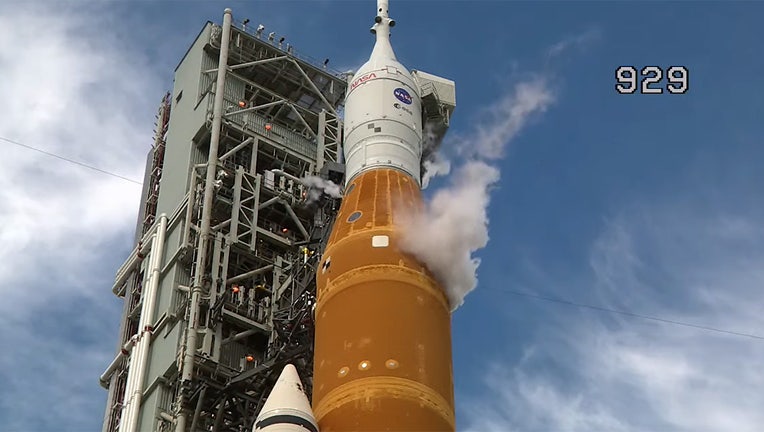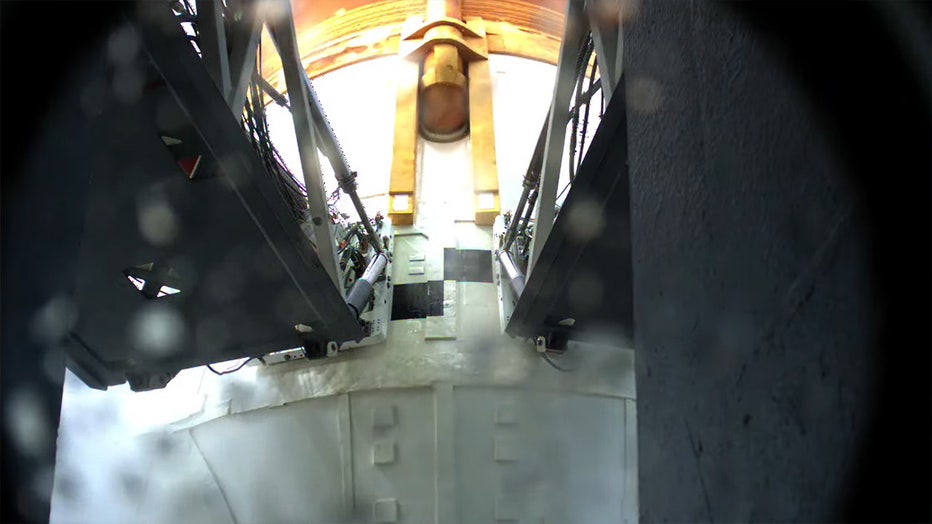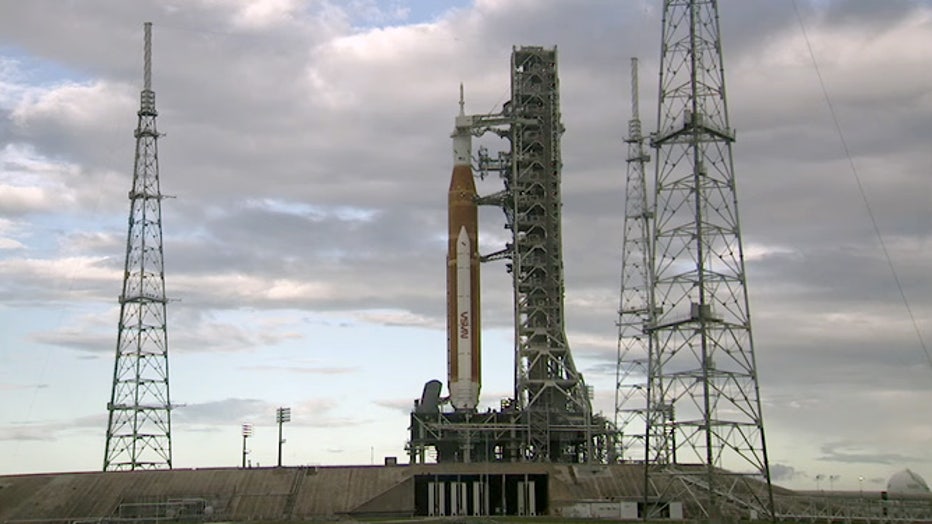Artemis I moon rocket fueling test complete after NASA engineers overcome hydrogen leak

In this shot from NASA TV, the Artemis I fueling test is underway on Wednesday, Sept. 21.
CAPE CANAVERAL, Fla. - NASA encountered some trouble early in the day Wednesday as the space agency tested to determine if a fuel leak on the Artemis I rocket was fixed. Still, engineers were able to problem-solve and move forward with the tanking test that NASA managers are calling successful.
A fuel leak scrubbed the space agency's most recent launch attempt of the mega moon rocket from Kennedy Space Center in Florida earlier this month.
The Space Launch System rocket with the uncrewed Orion spacecraft is slated to launch possibly next week on its maiden voyage known as the Artemis I mission, sending Orion around the moon and back.
On Wednesday, a fueling test at KSC was used to determine if engineers successfully fixed a fuel leak on the giant moon rocket. However, another leak popped up soon after the liquid hydrogen "fast fill" began on the rocket's core stage. Engineers were ultimately able to fill the SLS rocket's core and upper stage, although several hours behind the original timeline.
During the test, NASA attempted a "kinder and gentler" approach using lower pressure to fill the 322-foot-tall SLS rocket with thousands of gallons of cryogenic fuel.
NASA's deputy associate administrator for Exploration Systems Development Tom Whitmeyer explained that unlike liquid oxygen, which is "pumped" into the rocket, hydrogen requires pressure to move the light molecules.
"We're taking these transitions at a slower rate," Whitmeyer said. "The crunch in pressure and temperature changes will be more gradual."
‘Manageable’ liquid hydrogen leak
After a brief delay due to a person within the blast danger zone, Launch Director Charlie Blackwell-Thompson gave the "go" to begin fueling at 7:30 a.m. EDT, about a half-hour behind the original timeline.
During the test, both the SLS core and upper stages needed to go through all three phases of fueling, including slow fill, fast fill and replenish.
The first hiccup occurred when the team moved to the fast-fill stage of liquid hydrogen. NASA communications representative Derrol Nail said a 7% leak was detected, much higher than the 4% safety limit.
By mid-morning, NASA engineers successfully troubleshot the leak, which happened in the same manner as during the Sept. 3 launch attempt.
After stopping the propellant fill and warming up the fuel line, the liquid hydrogen fueling continued, but another minor leak popped up - though this one was well below the safety limit. The fix appeared to have worked, and fueling continued into the afternoon.
By 1:30 p.m., the core stage was 100% full of liquid oxygen and hydrogen, and the previous leak was down to 0.5%, which was good news for the launch team.
Nail said the leak was a "manageable" one, and the seal that teams replaced to fix the issue appeared to be working as designed.

NASA TV view of the quick disconnect valve, where the fuel pipe meets the Artemis I rocket.
The launch director gave the "go" to fill the rocket's upper stage just after 2 p.m. The upper stage, or the Interim Cryogenic Propulsion Stage (ICPS), is built by United Launch Alliance and provides the thrust to leave Earth orbit and send Orion onto the moon.
Just before 4 p.m., the rocket was fully fueled, and the liquid hydrogen tank was pressurized to pre-flight levels as it would be on an actual launch day. Another hydrogen leak appeared toward the end of the test above the conservative safety limit but this time in a different spot than the leak discovered earlier in the day.
It's unclear if NASA will call this test successful enough to move forward with another launch attempt.
Blackwell-Thompson said the tanking test "went really well."
As for a possible Sept. 27 launch, Blackwell-Thomson said: "We'll take a look at the data and see what it tells us. I am extremely encouraged by the test today."
The cryo-load test was another long day for NASA teams and lasted about 10 hours.
NASA has now attempted to get the rocket off Earth twice. Both attempts ended in launch scrubs.
During the most recent attempt on Sept. 3, a fuel leak of liquid hydrogen caused the launch director to scrub the liftoff.
The SLS requires more than 700,000 gallons of super-cold liquid hydrogen and liquid oxygen fuel to lift the 322-foot-tall rocket off the launchpad and into space. While an efficient rocket fuel, hydrogen is a tiny molecule that easily leaks. It has previously created problems for the space shuttle program.
SLS has also experienced hydrogen leaks during wet dress rehearsal tests and a small leak during the first launch attempt.

The SLS rocket, seen on Pad 39B, as the fuel test gets underway.
Teams at KSC launchpad 39B worked for the past two weeks to replace two quick-disconnect seals to the rocket in hopes of fixing the leak, which NASA managers described as a "major leak" well above the 4% limit.
During fueling on Sept. 3, the leak "spiked" to over 8%, KSC Exploration Ground Systems Program deputy manager Jeremy Parsons said.
"The reason where 4% is set is its kind of the flammability of hydrogen and air. So that's where you start to enter a certain amount of risk of flammability," Parsons said.
"It's really a relatively conservative limit," he added.
WHAT IS NASA'S ARTEMIS 1 MISSION GOING TO DO?
NASA SLS Chief engineer John Belvins said after reviewing all possible causes on the fault tree, he doesn't believe any one thing caused the leak.
On the 8-inch seal, engineers found an "indentation" that could have been caused by a hit from what NASA calls FOD, which stands for "foreign object debris." However, no FOD was found near the seal.
Next SLS launch depends on this test and Space Force's decision
Teams are targeting Sept. 27 for liftoff during a 70-minute window opening at 11:37 a.m. EDT. However, that all rides on the outcome of Wednesday's cryo-loading and if NASA gets approval from the Space Force.
"Ultimately, we've mitigated everything that we can think of, and we will know in the (next) 36 hours or so, or 48 hours, how effective those mitigations were," Belvins said Monday.
The Sept. 27 launch date and a backup window on Oct. 2 are under review by the Space Force, which manages the Eastern launch range.
Previously, NASA said the moon rocket would need to roll back to the Vehicle Assembly Building (VAB) due to safety requirements to replace flight termination system (FTS) batteries. The FTS is required on all rockets and would cause the vehicle to self-destruct if it veers off course and threatens the public.
"They're responsible for all the vehicles they launch, not just ours," Blevins said of Space Force. "And they'll make a decision whether we meet the requirements for public safety or not and will adhere to that decision."
The agency submitted a waiver to extend the FTS certification and is waiting to hear back from Space Force.
Tracking the tropics for the October launch window
As NASA managers have alluded to several times during briefings, the agency continues to monitor the tropics and any potential impacts on the Space Coast.
The latest tropical weather outlook shows a disturbance approaching the Caribbean has a high chance of developing into a tropical cyclone over the next five days.
The FOX Forecast Center said that through at least Tuesday, the tropical weather threat will remain in the Caribbean. Still, forecast models show the potential system lifting northward and possibly making it into the Gulf of Mexico.
It is too soon to tell how strong the system will be or who it will threaten. However, NASA leaders will likely keep a close eye on the potential tropical trouble.
If a tropical system approaches, the space agency would likely need to roll the SLS back into the VAB. It takes about three days to prepare for a rollback, and the rocket cannot begin moving to the hangar with more than 46 mph winds.

